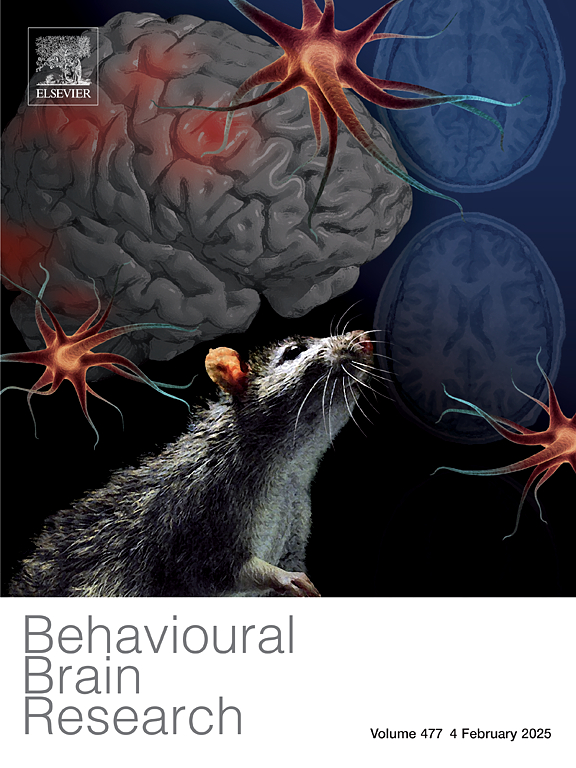情景记忆和生殖条件可以独立影响雄性草原田鼠(Microtus ochrogaster)的配对维系:精神分裂症亚临床表现研究的生态学意义和翻译相关性
IF 2.3
3区 心理学
Q2 BEHAVIORAL SCIENCES
引用次数: 0
摘要
对草原田鼠(Microtus ochrogaster,一种社会一夫一妻制啮齿动物)交配策略的研究表明,该物种的生殖配对和一夫一妻制与社会空间记忆能力的增强有关。在本研究中,我们在与雌性共处一段较长时间的雄性田鼠中测试了这种可能性,方法是采用一种行为测试来评估社会记忆、物体记忆、社会空间记忆和物体空间记忆的熟悉性回忆(FR)和新颖性检测(ND)成分。我们还评估了每只雄性田鼠相对于不熟悉的雌性田鼠,对其配偶表现出亲和行为的偏好,以及这对田鼠的繁殖成功率。我们发现,社会空间刺激的ND和繁殖成功是雄性对其配偶雌性依恋偏好的独立正预测因子。社会、物体和物体空间刺激的ND与男性附属偏好无关,FR对这些刺激的反应也与男性附属偏好无关。生殖成功与对象空间ND和社会空间ND均相关。综上所述,目前的研究结果表明,草原田鼠对伴侣关系的维持与个体同种物及其空间位置之间的关联变化的检测和/或关注的增加有重要关系。独立而言,繁殖成功似乎有利于发现物体空间和社会空间的新颖性。这些结果讨论了田鼠的自然历史,以及在他们可能的意义背景下阐明情景记忆缺陷和功能失调的社会行为之间的关系在病理条件下,如精神分裂症。本文章由计算机程序翻译,如有差异,请以英文原文为准。
Episodic memory and reproductive condition could independently influence the pair bond maintenance in the male prairie vole (Microtus ochrogaster): Ecological implications and translational relevance in the study of sub-clinical manifestations of schizophrenia
Investigations on mating tactics of the prairie vole (Microtus ochrogaster, a socially monogamous rodent) have suggested that reproductive pair bonding and monogamy in this species are associated with increased capacity for social-spatial memory. In the present study, we tested this possibility in male voles that had been co-housed for an extended period with a female, by applying a behavioral test designed to assess familiarity recollection (FR) and novelty detection (ND) components of social, object, social-spatial, and object-spatial memory. We also assessed each male vole’s preference to display affiliative behavior toward his mate, relative to an unfamiliar female, as well as the reproductive success of the pair. We found that ND of social-spatial stimuli and reproductive success were independent positive predictors of the male’s affiliative preference for his partner female. ND of social, object, and object-spatial stimuli were not associated with male affiliative preference, nor were FR responses to any of these stimuli. Reproductive success was associated with both object-spatial and social-spatial ND. Taken together, the present results indicate that pair bond maintenance in the prairie vole is importantly associated with increased detection of and/or attention to alterations in associations between individual conspecifics and their spatial location. Independently, reproductive success appears to favor detection of object-spatial and social-spatial novelty. These results are discussed in relation to vole natural history, as well as in the context of their possible significance for elucidating relationships between episodic memory deficits and dysfunctional social behavior in pathological conditions such as schizophrenia.
求助全文
通过发布文献求助,成功后即可免费获取论文全文。
去求助
来源期刊

Behavioural Brain Research
医学-行为科学
CiteScore
5.60
自引率
0.00%
发文量
383
审稿时长
61 days
期刊介绍:
Behavioural Brain Research is an international, interdisciplinary journal dedicated to the publication of articles in the field of behavioural neuroscience, broadly defined. Contributions from the entire range of disciplines that comprise the neurosciences, behavioural sciences or cognitive sciences are appropriate, as long as the goal is to delineate the neural mechanisms underlying behaviour. Thus, studies may range from neurophysiological, neuroanatomical, neurochemical or neuropharmacological analysis of brain-behaviour relations, including the use of molecular genetic or behavioural genetic approaches, to studies that involve the use of brain imaging techniques, to neuroethological studies. Reports of original research, of major methodological advances, or of novel conceptual approaches are all encouraged. The journal will also consider critical reviews on selected topics.
 求助内容:
求助内容: 应助结果提醒方式:
应助结果提醒方式:


